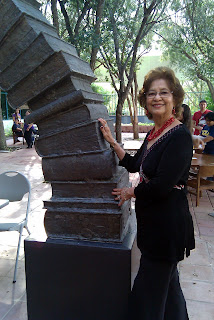“The biggest mistake a writer can make is not taking the time to fully understand the publications, publishing houses, or literary agents she queries.” – Writing Tip from Writer’s Digest Weekly Planner
Monthly Archives: October 2011
San Marcos Texas Author Day
From the San Marcos Mercury: “These published writers and illustrators will sign copies of their books and chat with fans. A variety of genres will be represented including Texana, mystery, romance, memoirs, children’s literature, poetry, and non-fiction.”
 |
| San Jose Mission Window |
“ … one day you experience a new joy, that of your story being published (giving birth). Everyone sees this beautiful thing that you have created. They will dress it up (illustrations and packaging). Family and friends shower you with praise.” These are some of the words Shirley G. Webb wrote on her post, “A Book is Born,” for the Institute of Children’s Literature blog. It’s a wonderful piece that addresses the passion, the revisions, the rejections, and all that goes into the process of finally getting a book published.
Word choice in scenes
 |
| Pinatas |
“I try to leave out the parts that people skip.” – Elmore Leonard
Handwriting in cursive
 |
| Aguas Frescas |
The Chautauqua Experience
“A writer is the verbal painter,” said Peter Jacobi, professor emeritus of journalism at Indiana University. He used examples of art and music, sensual art versus impact.
“Capture your reader,” he said. “Think first, plan, then write.” Some of his writing tips:
§ Promise and deliver – The first page should set subject, tone and direction. Then what you promised the reader must began to be delivered.
§ Flow – Make your narrative flow steadily ahead. A river of words unbroken from start to finish.
§ Clarity in language – Lucidity in thought. Word choice. Seek to find the right one.
§ Rhythm – Listen to your sentences as they grate against the mind. How do they come together?
§ Movement – Do not bind your story with a pile of ingredients where there is no sense of movement or forward propulsion of your story.
§ Surprise the reader with the unexpected from left field.
§ X-ray – Take the reader behind the scenes.
“Nice writing is not enough,” he said. “Surprise the reader along the way. Do not write the fact that it’s raining, but the feel that you’re being rained upon.”
Writing Animal Stories
I once wrote a story about a dog that was rescued from the animal shelter by a family when they saw him perform in a local school play, Little Orphan Annie. Although it hasn’t been published yet, I’m thinking of resubmitting. I took it out of my file, read it again, and decided it’s pretty darn good. I might just resurrect it someday soon and send it out.
This thought was triggered when I read the post, “5 Tricks Animal Writers Should Know,” on Writer’s Digest Chuck Sambuchino’s Guide to Literary Agents Blog. The guest column by Patti Sherlock, award-winning author, (latest book, A Dog for All Seasons), offers tips on how to write animal stories starting with “Respect what animals mean to your audience.” Take a peek.
Book Events
 |
| Courtyard – Harlingen Public Library |
 |
| Mark Twain and Author |
“To do without tales and stories and books is to lose humanity’s past, is to have no star map for our future.” – Jane Yolen

